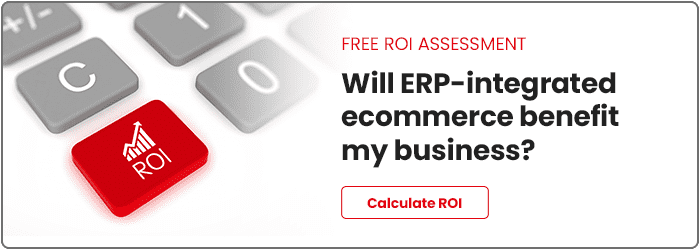
3 ecommerce KPIs you can measure from your ERP

Marketing Team
k-ecommerce
This article on ecommerce KPIs was originally featured in ERP SoftwareBlog.

Key performance indicators (KPIs) aren’t a new concept in the business world. Companies across the globe have used them for decades to gauge performance and guide decision-making.
With the digital revolution, new KPIs specific to doing business on the web have emerged. However, many of the best KPIs for ecommerce websites are the same indicators that offline companies use to assess business performance.
This means you can still use your ERP to gather vital KPI data for your ecommerce venture — just like offline businesses do. And if you’re using an ecommerce solution that integrates seamlessly with your ERP, the data transparency between the two systems makes the analysis even easier.
We’ll look at the basics of ecommerce KPIs, why they matter, and a few you can measure directly from your ERP. Here’s what you’ll learn:
- What Are KPIs for Ecommerce?
- Why Are KPIs for Ecommerce Websites Important?
- How To Determine the Best KPIs for Ecommerce To Measure
- The Best Ecommerce KPIs To Track Using Your ERP
- Final Word: The Best Ecommerce KPIs To Measure From Your ERP
What Are KPIs for Ecommerce?
KPIs for ecommerce websites are quantifiable measures that help ecommerce companies assess and track performance or progress toward specific business objectives.
The term “KPI” is sometimes used interchangeably with “metric,” but there are some important differences. All KPIs are metrics, but not all metrics are KPIs.
Metrics track and assess the status of a specific process in a business. KPIs are a subset of metrics tied directly to business objectives. Essentially, for a metric to qualify as a KPI, it has to have meaningful business value attached to it.
For example, the total number of visitors (i.e., website traffic) is an important ecommerce metric. However, it doesn’t hold much business value by itself, so it’s technically not a KPI.
Your conversion rate, on the other hand, has a direct impact on your company’s bottom line and thus meets the criteria of a KPI.
Why Are KPIs for Ecommerce Websites Important?
Tracking the KPIs of your online business helps with the following aspects.
Performance Measurement and Monitoring
KPIs provide quantifiable measures to evaluate your online store’s performance. They help determine whether you’re on course to achieve what you set out to do or way off and need to restrategize.
Data-Driven Decision Making
The competitive nature of the ecommerce industry means that businesses need to make decisions based on hard data rather than instinct. KPIs provide you with useful insights you can use to make better business decisions.
Resource Allocation
Tracking ecommerce KPIs allows you to identify what’s working and what’s not. This enables smarter resource allocation to maximize your return on investment (ROI).
Proactive Problem Identification
KPIs can also serve as an early warning system, enabling you to fix small issues before they become big problems. For example, if you notice a sudden increase in your shopping cart abandonment rates, this could signal an issue with your checkout process.
How To Determine the Best KPIs for Ecommerce To Measure
Here are a few best practices for determining the most appropriate KPIs to measure for your ecommerce business.
1. Check What Other Players in Your Niche Are Tracking
Looking at what others in your niche are measuring can be a good place to start. Just keep in mind that not all of these KPIs may be applicable to your unique business context.
2. Confirm Alignment With Your Business Objectives
Your KPIs should resonate with your business goals or objectives. They should provide insights that help you get closer to or meet these objectives.
3. Confirm Data Availability and Measurability
The best ecommerce KPIs have data that is easy to access or track. The more seamless the data collection, the more consistent you can be in monitoring and acting on the information you gather.
4. Consider Relevance to Stakeholders
Consider who will be using KPIs and why. The KPIs you monitor should offer value or actionable intelligence to relevant stakeholders — whether it’s your business’s marketing team, executives, or investors.
5. Consider Ease of Interpretation
If a KPI is too complex or difficult to interpret, its usefulness will be limited. Focus on KPIs that are easy to understand for everyone involved.
The Best Ecommerce KPIs To Track Using Your ERP
ERPs make it easy to collect and analyze some of the most important KPIs for assessing performance. Here are several of the best ecommerce KPIs you can measure directly from your ERP.
Cost of Goods Sold
The cost of goods sold (COGS) is the total cost of producing and delivering the goods you offer on your ecommerce store. It includes manufacturing or acquisition costs, related employee costs, and other expenses.
Measuring COGS can provide you with a foundational understanding of profitability — gross profit is calculated by subtracting COGS from revenue.
Tracking COGS can also shed light on your operational efficiency. For example, a high COGS could signal inefficiencies like poor inventory management, overstaffing, and outdated production equipment.
How To Optimize COGS
- Buy in bulk to reduce per-unit costs.
- Ask several suppliers for quotes to find the most cost-effective options.
- Negotiate with your current supplier(s) for a better price.
- Optimize operational efficiency. For example, an ERP-integrated ecommerce solution naturally lowers operating costs by automating time-consuming business tasks like order processing.
Average Order Value (AOV)
Average order value (AOV) refers to the average amount spent each time a customer places an order on your ecommerce site. At the time of writing, the global ecommerce AOV was $112.
Tracking your AOV can help you understand purchasing patterns. For example, do they buy more or fewer items per order? Do they purchase more lower-value items than higher-value items or vice versa?
Depending on your circumstances and goals, you can adjust your sales and marketing strategies accordingly.
How To Optimize AOV
- Cross-selling: This involves suggesting related or complementary items to ecommerce website visitors. For example, if a customer is browsing printers, you can configure your online store to recommend ink cartridges and paper.
- Upselling: This tactic entails encouraging a customer to upgrade to a higher-value item. For example, if you see a site visitor checking out the basic package of your software, you can highlight the benefits of the premium version to encourage them to upgrade. According to a 2022 HubSpot survey, companies that cross-sell and upsell get up to 30% of their total revenue from these tactics.
- Free shipping thresholds: This involves using your ERP-integrated ecommerce solution to set a purchase or order amount that qualifies the customer for free shipping. A 2023 Shippo report shows that 47% of shoppers are willing to spend a minimum amount to get free shipping.
- Bundling: With this tactic, you offer packages or sets of related products at a reduced price.
New Customer Orders vs. Returning Customer Orders
This KPI compares the number of orders from new customers to returning customers. It offers several useful insights about your acquisition and customer retention strategies.
A higher ratio of new to returning customer orders may mean your acquisition strategies are working. However, it might call into question your ability to retain customers.
Conversely, a higher percentage of orders from repeat customers is a sign of strong brand loyalty. It means that your products, services, and overall customer experience resonate with a large number of customers. However, it might hint at the need to ramp up your efforts in acquiring new customers.
How To Optimize New Customer Orders vs. Returning Customer Orders
Ultimately, the goal should be to strike a good balance between new and returning customer orders.
If the number of new customer orders is low, you can start a digital marketing campaign that includes some of the following strategies to increase the number of new buyers:
- PPC marketing
- Social media marketing
- Search engine optimization (SEO)
- Email marketing
- Affiliate marketing
If the number of returning customer orders is lagging, revisit or add new customer loyalty and retention strategies, such as exclusive deals for existing clients to encourage repeat purchases.
Pro Tip: If you need to prioritize either acquiring or retaining customers, go for the latter. It’s less expensive to retain a customer than to acquire a new one. Plus, returning customers have a higher AOV than new shoppers.
Final Word: The Best Ecommerce KPIs To Measure From Your ERP
We’ve looked at three important ecommerce KPIs in this guide. However, there are many more important KPIs you can measure — such as return on ad spend (ROAS), customer satisfaction score (CSAT), customer lifetime value (CLV), customer acquisition cost (CAC), churn rate, and total cost of ownership (TCO) — all of which are paramount to your business’s growth.
With an ERP-integrated ecommerce platform from k-ecommerce, many crucial KPIs are readily accessible. We make it easier than ever to evaluate business performance, adapt strategies, and foster growth.
Get in touch with us today to learn more.



